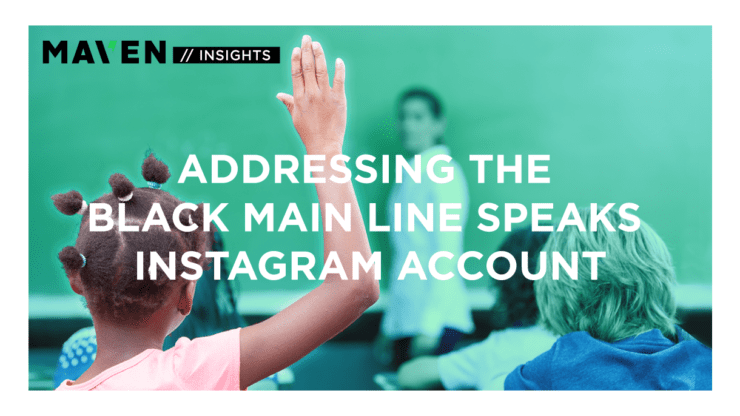By Jessica Sharp of Maven Communications and Matthew Ray of ChatterBlast
The increased and long-late awareness around the Black Lives Matter movement in recent weeks has presented itself in many ways across the country. Here in Philadelphia, an Instagram account, Black Main Line Speaks, has gained momentum. The account allows any Black community member of any of the Main Line schools of Philadelphia to submit a story about their experiences.
These stories range from blatant, overt acts of racist behavior and language to the microaggressions, embedded racism, and systematic white supremacy that are ingrained and upheld in less immediately overt ways.
It’s pretty eye-opening. It’s also painful. But that’s the point.
There is no denying or downplaying the impact that this moment is having. Unlike many other moments in time where it seems as if momentum is picking up, only to have it recede as quickly as it began, this movement feels different, because it is different.
There are few parts of our society that have not been affected by the current social awakening. One of the biggest differences this time is that Gen Z is a large part of it. They grew up on Instagram. This platform is their playground, soapbox, and dating pool. This is also the population that fills K–12 schools. And to be honest, it isn’t just students on here either.
As communicators, we see this moment as an opportunity. It’s an opportunity for K–12 schools on the Main Line to become a real part of the conversation. This is a moment to create thoughtful and meaningful change on the Main Line. It’s an opportunity to listen to and give a voice to black and brown students who are our future leaders.
Although we have no affiliation with these schools, if we did, these are the steps we would recommend they take:
Acknowledge that this is happening.
Ignoring any type of social voice is a mistake. While the information and emotion shared on this Instagram account, for example, might seem like an attack or criticism, schools should see this as a genuine moment to listen to students, parents, and teachers. The point isn’t to suppress or obfuscate this type of storytelling, even if it paints a negative picture of the school. This is a learning moment and the best teachers always learn too. Each social post should be digested and acted upon, even if it doesn’t address your institution. Every school can find something powerful here.
Create a coalition.
Each school must take immediate steps to proactively and powerfully solve issues around systemic racism, acknowledging that each school has a different pain point. Each institution should form diverse groups of student leaders, educators, parents and activists empowered to formulate short- and long-term plans to move forward. It’s imperative that the coalitions include individuals whose voices have not been heard before, or have been unseen in previous planning processes. The group must also function under collaborative leadership to ensure constructive solutions to address shared concerns.
Develop a comprehensive plan.
We’re well beyond lip service at this point. The primary role of the coalition should be to put together a comprehensive plan to build a stronger and more inclusive educational community. A comprehensive plan includes overall goals and specific objectives, defined target audiences, specific initiatives designed to address the needs of each target audience and guidelines for how success will be measured. It’s important that the coalition is transparent about the process and steps it takes.
This isn’t just an external public relations campaign or social media moment, this is a real opportunity for each school to listen and learn. The plan is less about communicating value to the outside world, and more about creating an internal environment of equity. That won’t happen without an exchange of words, ideas and emotions. Person-to-person communication and understanding are the goals here.
Identify a spokesperson.
While the coalition should consist of a diverse group of people, one person, preferably a person of color, should be identified as the spokesperson for the group to ensure consistency of message and accountability. This person should serve as a coalition convener, and succinctly address the at-large community on the problems and solutions arising on campus. They should receive support from the school, ranging from media training to town halls, and they should be empowered and respected.
Meet them where they are.
Gen Z is a digital-first generation. That means to communicate with them in a way that they’ll listen, you need to engage on their platforms. Your social media will need to reflect the learning and healing process, not just turn on a diversity campaign. Empower students who might feel unseen or shut-out of your digital presence to step forward and be visible. Share updates on your growth as a community, your work towards dismantling elitist systems, and your continued plans and successes. Consequently, most Boomers’ idea of over-communication is under-communication to Gen Z, so be transparent and authentic.
Continue to listen, continue to learn.
And at all times, never let the need for YOU to speak overwhelm the clear and present need to listen. This account says some horrible things about some storied schools. For alumni, students, and faculty it can be devastating.
However, at no point in time should we try to stifle this expression. We have to listen, and we have to learn. Additionally, learning may also require your collaboration or partnership with new allies, like anti-racism experts or psychologists. To be clear, this is not a communications problem. It’s an institutional one.
We all have a role to play in this moment. For Main Line schools, that role is to take these actions as the first steps in making meaningful change.
Posted In Crisis Communications
 Jessica Sharp
Jessica Sharp 

